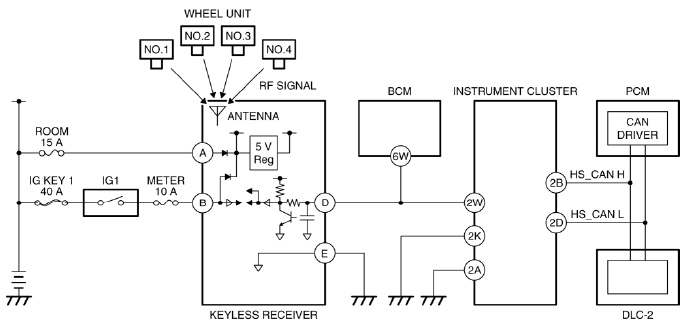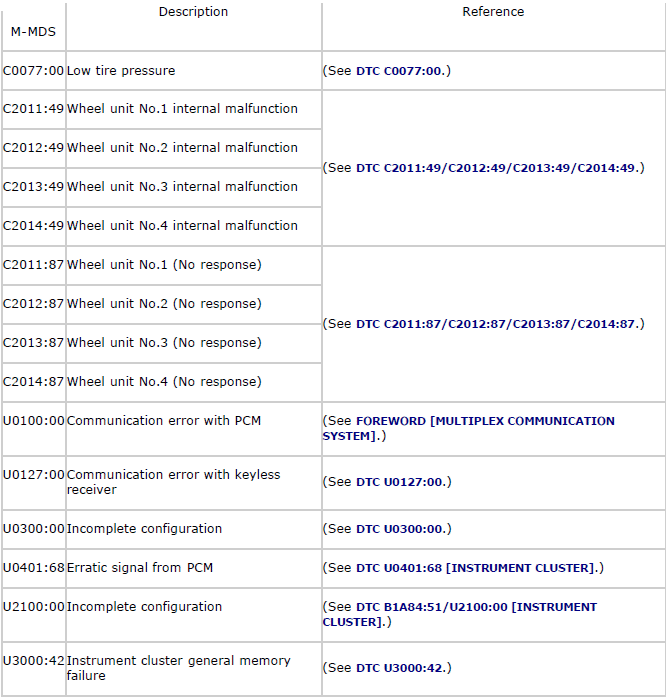Mazda 2: Tire Pressure Monitoring System (TPMS)
TIRE PRESSURE MONITORING SYSTEM (TPMS) WIRING DIAGRAM

TIRE PRESSURE MONITORING SYSTEM (TPMS) ON-BOARD DIAGNOSIS
On-Board Diagnostic (OBD) Test Description
- The OBD test inspects the integrity and function of the TPMS and outputs the results when requested by the specific tests.
- On-board diagnostic test also:
- Provides a quick inspection of the TPMS usually performed at the start of each diagnostic procedure.
- Provides verification after repairs to ensure that no other faults occurred during service.
- The OBD test is divided into 2 tests:
- Read/clear diagnostic results, and PID monitor.
Read/Clear Diagnostic Results
- This function allows you to read or clear DTCs in the instrument cluster memory.
PID/Data Monitor And Record
- This function allows you to access certain data values, input signals, calculated values, and system status information.
Reading DTCs Procedure
1. Connect the M-MDS (IDS) to the DLC-2.
2. After the vehicle is identified, select the following items from the initialization screen of the IDS.
- Select "Self Test".
- Select "Modules".
- Select "IC".
3. Verify the DTC according to the directions on the screen.
- If any DTCs are displayed, perform troubleshooting according to the corresponding DTC inspection after recording the snapshot data. (See Snapshot Data Table).
4. After completion of repairs, clear all DTCs stored in the instrument cluster. (See Clearing DTCs Procedures).
Clearing DTCs Procedures
1. Connect the M-MDS (IDS) to the DLC-2.
2. After the vehicle is identified, select the following items from the initialization screen of the IDS.
- Select "Self Test".
- Select "Modules".
- Select "IC".
3. Verify the DTC according to the directions on the screen.
4. Press the clear button on the DTC screen to clear the DTC.
5. Switch the ignition to off.
6. Switch the ignition to ON and wait for 5 s or more.
7. Perform DTC inspection. (See Reading DTCs Procedure).
8. Verify that no DTCs are displayed.
PID/Data Monitor And Record Procedure
1. Connect the M-MDS (IDS) to the DLC-2.
2. After the vehicle is identified, select the following items from the initialization screen of the IDS.
- Select "DataLogger".
- Select "Modules".
- Select "IC".
3. Select the applicable PID from the PID table. (See PID/Data Monitor Table).
4. Verify the PID data according to the directions on the screen.
NOTE:
- The PID data screen function is used for monitoring the calculated value of input/output signals in the module. Therefore, if the monitored value of the output parts is not within the specification, it is necessary to inspect the monitored value of input parts corresponding to the applicable output part control. In addition, because the system does not display an output part malfunction as an abnormality in the monitored value, it is necessary to inspect the output parts individually.
DTC Table


PID/Data Monitor Table
NOTE:
- When the wheel unit is in sleep mode, the data logger displays a value
different from
the actual value. (Such as, WU1_P: 0 KPa, WU1_T: -50

